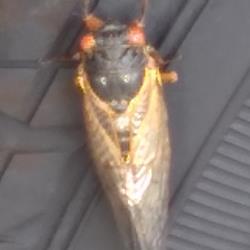Cicadas and Trees: What You Should Know

The massive numbers of 17 year periodical cicadas that make up Brood X have begun to emerge. Fortunately they do NOT eat tree leaves or branches but they may still be an issues for very young trees.
The cicadas are harmless to people, but their egg laying is potentially damaging to young trees. According to Suzanne Clingman, the township’s Greenspace inspector and biologist, most smaller trees will probably survive this “natural pruning” provided by the cicadas as they lay their eggs. However, this process can sometimes do enough damage to kill small trees, Clingman said. This pruning is no problem at all for larger trees and may actually be helpful and cause a vigorous bloom next year.
Cover trees with very lightweight netting if they were planted last fall, Clingman said. Mesh tree bags can be purchased online that will cover the crown of the young tree and can be closed where the lowest branches meet the trunk. Trees only have to be protected for the two or three weeks when cicadas are at their peak, she said. There is no need to wrap the trunk for protection. The nymphs that crawl up the trunk do not lay eggs. Adult females will fly into the trees and slit small branches and deposit eggs inside.
Do not use pesticides to try and kill the cicadas as important pollinators can be killed as well. By the Fourth of July all the cicadas will have finished their life cycle and died.